Home > Articles > Special Series > Bill Emerson’s Bluegrass Life After the Navy
Bill Emerson’s Bluegrass Life After the Navy
When Bill Emerson retired from the Navy in 1993, at the age of 55, he was far from retiring from his life in bluegrass music. He continued to record and perform with various artists and then he later started his band, Bill Emerson and Sweet Dixie. In an interview conducted by John Lawless and printed in the 5-String Quarterly in the fall of 1995, Bill said, “Having achieved the goal of going in the Navy and retiring with a pension, I now have the freedom to lay back, and not have to go work as a cab driver. I can do my art at my leisure, pick and choose the jobs I do, and who I want to play with. Needless to say, this really enhances my ability to make quality music.”
This article will cover Bill’s work from the time he left the Navy in 1993 up until the time he formed his band Sweet Dixie in 2006.
Bill Emerson and Tony Rice
In 1993, Bill Emerson worked on two new recordings. The first was Tony Rice’s Tony Rice Plays and Sings Bluegrass. The second was the Bill Emerson and Wayne Taylor recording Appaloosa. Bill Emerson and Tony Rice had a great mutual respect for one another as musicians and they were good friends. Bill used Tony on his solo recordings and when Tony needed a banjo player in the band, he called on Bill. In the liner notes to Tony Rice Plays and Sings Bluegrass, Emerson is quoted as saying, “Tony’s a great musician. The energy just comes off that guy like you wouldn’t believe! Playing with Tony is one of the highlights of the thirty-something years of my career.”
From the time he recorded his landmark album Manzanita, in 1979—which was labeled “bluegrass without a banjo”—Tony did not carry a banjo player in his band, The Tony Rice Unit. Between 1992 and 1994, Rice recorded three albums that reached back to provide a more traditional bluegrass sound and the banjo player he selected for those three recordings—The Rice Brothers, Tony Rice Sings and Plays Bluegrass, and The Rice Brothers 2—was Bill Emerson.
Bluegrass guitar players who have spent a lot of time watching Tony Rice’s right and left hands—in an effort to learn how he effortlessly moved around the guitar’s fingerboard—know very well that in addition to wearing gold rings on some of the fingers of both his right and left hands, Tony wore an Accutron watch on his left wrist and a gold bracelet on his right wrist. What they may not know is that the bracelet that Tony wore for many years was a gift from Bill Emerson.
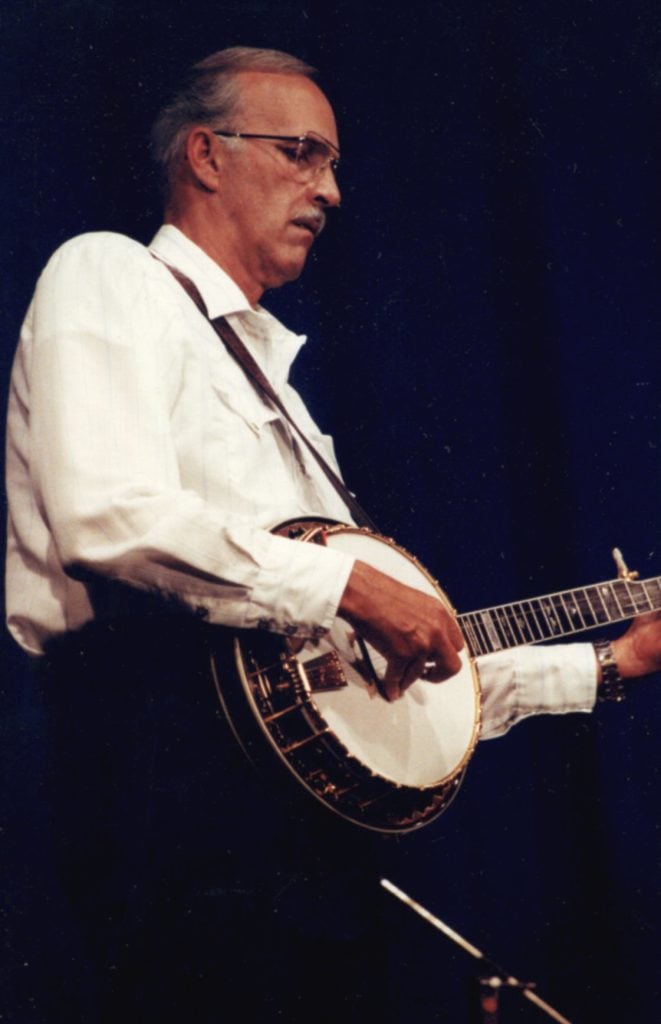
Bill’s son, Mike Emerson, explains that starting in about 1983, his mother and father formed a business called The Blueridge Company. Bill and Lola Emerson partnered with Bud and Mae Laedtke and opened a store in Vienna, Virginia called Village Antiques. At the store, Bud and Mae sold high end furniture and Bill and Lola sold various “accessories” such as picture frames, brass candle holders, antique travel trunks, jewelry, and artwork by David Knowlton (whose paintings appeared on the covers of two of Emerson’s recordings—Home of the Red Fox and Tennessee 1949). Since Bill was in the Navy at the time, Lola handled the day-to-day running of the store.
One of the jewelry vendors that supplied Bill and Lola gold jewelry was selling bracelets that Bill liked, and he bought one for himself and another for his wife. Sometime in the early 1990s, Bill Emerson was with Tony Rice and he was wearing his gold bracelet. Rice mentioned how much he liked the bracelet and Emerson gave it to him. In some photographs taken of Emerson, you can see him wearing the matching bracelet, this is the one that he had purchased for his wife.
When asked about the bracelet that Tony wore, Wyatt Rice confirmed that he got it from Bill Emerson. Wyatt remembers that the Tony Rice Unit was playing a gig at venue called Mr. B’s in Fredricksburg, Virginia. Bill Emerson came to the show and sat in with the band. Bill was wearing the bracelet when he came to the gig. Later, Wyatt saw Tony wearing the bracelet and Tony told him that Bill had given it to him. Wyatt said that Tony eventually had more than one gold bracelet, but Bill Emerson had given him that first one.
In addition to playing on the three Rice recordings, Bill also performed live with Rice to promote the records. A December 1993 listing in the Washington Post advertises a show at a local D.C. club (Tornado Alley in Wheaton, Maryland) that Rice was playing in support of the Sings Bluegrass album. Additionally, Mike Emerson is in possession of cassette tapes of live shows that Emerson performed with the Rice Brothers at the California Bluegrass Association festival in June of 1995.
Bill Emerson and Wayne Taylor
By the time they recorded their album Appaloosa for Webco Records, Bill Emerson and Wayne Taylor had been playing music together since Wayne joined the Navy’s country and bluegrass band Country Current in 1987.
The liner notes to Appaloosa, written by radio host Lee Michael Demsey, sums up Bill’s years leading up to the recording of this album as follows:
In the last five years Bill has been laying the ground work for the resurgence of his Bluegrass career. Here’s a sampling of the last five years: along with songwriting master Pete Goble, Bill released two extremely well received hit albums as Emerson and Goble on Webco Records of Virginia, in 1985 and 1988. Along with guitar master Tony Rice, Bill has released two highly acclaimed instrumental albums on Rebel Records, in 1988 and 1991. Bill has also recorded extensively on projects with Tony Rice over the last few years, as well as producing recordings for artists such as Larry Stephenson, Jimmy Gaudreau, and Bill’s latest protégé, Wayne Taylor.
Paying homage to Bill’s tremendous banjo prowess, Stelling Banjo Works, Limited, issued a signature series of the Bill Emerson Red Fox model in 1990, as well as a Bill Emerson line of banjo gear. In August 1992, Webco Records of Virginia released Bill Emerson’s Reunion album. Reunion is a collection of new recordings featuring some of the legendary lead-singer/guitar players Bill has worked with over the years, including Jimmy Martin, Charlie Waller, Red Allen, and Tony Rice among others. Reunion garnered best album final nominee awards from the International Bluegrass Music Association [IBMA] and the National Association of Record Distributors!!
Bill Emerson introduced Wayne Taylor to the recording consumer on his Reunion album with one of Wayne’s original songs, MY SMOKY MOUNTAIN HOME. For the last seven years, Wayne Taylor, has been musically associated with Bill as lead-singer guitarist in the Country Current. In June 1993, Bill retired from the U.S. Navy Band.
Bill’s association with Wayne has truly blossomed over the years and it has produced the powerful album you now hold in your hands. Bill says of Wayne Taylor, “Wayne is the most versatile singer that I’ve ever been associated with. Wayne’s vocal ability covers a gambit of musical styles and is equally polished across the board. His composing talent is superb, and on top of it all Wayne is an excellent guitar player!”
Bill Emerson and Wayne Taylor have gathered here a list of master acoustic musicians to put forth a tremendous album. Chock full of variety and performed with the utmost talent. The supporting cast here includes Tony and Wyatt Rice, Rickie and Ronnie Simpkins, Jimmy Gaudreau, Mark Schatz, Mike Auldridge, Robert Sullivan, and Mick Nicholson. Last, but certainly not least, Dan Tyminski, a Lonesome River Band and Alison Krauss and Union Station alumni, provides all of the vocal harmonies. The combination of Emerson and Taylor talent and original compositions, along with these high-caliber players, equals a treasure chest of recorded performances!
Regarding the Appaloosa album, Wayne Taylor said that soon after he joined the Navy band in 1987, Bill Emerson had said to him “We are going to do a CD together.” Wayne said that every once in a while he would “pester” Bill about it. Emerson finally said, “If you put the money together, I’ll find the musicians and the recording studio.” Taylor worked on writing songs and saving money and when he was ready, he approached Emerson and they started working on the album.
Emerson called his musician friends (see the “supporting cast” list in the liner notes above) and the group went into Big Mo Studio in Kensington, Maryland with engineer Ronnie Freeland and started recording. One of the tunes that appeared on the recording (“Lonesome Pine Breakdown”) was something that Emerson had recorded with Tony Rice for a previous solo project, but it had not made that record, so they used it on Appaloosa. Another song that was recorded during the Appaloosa sessions (“My Smoky Mountain Home,” a Taylor original) was not placed on the Appaloosa album, but was used by Emerson on his Reunion album.
Of the thirteen cuts that appeared on Appaloosa, four were written by Wayne Taylor and three by Bill Emerson. Two of the Emerson tunes (“Tex-Mex Shindig,” and “Espanol”) had a Mexican music feel to them. Wayne Taylor said that they only played one live show—at a festival in Plymouth, California—in support of the recording. Bill Emerson had left the Navy by then, but Taylor was still in the Navy and performing with Country Current. Country Current was booked to play the festival and Bill Emerson came out with mandolin player Emery Lester. Country Current played their show and then three members of the Navy band (Wayne Taylor, Pat White, and Joe Wheatley) changed out of their Navy uniforms and played with Emerson and Lester. Wayne Taylor recalls that Bill’s son, John Emerson, was going to try to book more shows, but he said, “We discovered that the Navy frowned on that.” The Navy did not want members of Country Current to play music outside of their scheduled shows with the Navy band.
The recordings that Bill Emerson worked on during the early-to-mid 1990s seemed to run together and overlap to some degree. As mentioned above, a song that he recorded for one of his solo projects ended up on Appaloosa, and a song that he recorded in the studio with the Appaloosa band ended up on Reunion. Also, songs that were recorded in 1985 and 1989 were added to songs that he recorded in 1995 to complete his Banjo Man album, which was released in 1996.
The Bill Emerson Banjo Book
In the early 1990s banjo player John Lawless started a business called AcuTab. Originally, the company produced transcriptions books focused on the work of various banjo players. Later, they produced books relating to other bluegrass instruments and also produced instructional videos. That company is no longer in business as John Lawless has moved on to be the co-owner and manager of the bluegrass news website Bluegrass Today.
John explains that the company grew out of his desire to produce a book of banjo transcriptions for Sammy Shelor. After that book was published—and sold well—John wanted to produce similar projects for Terry Baucom and Bill Emerson. However, John did not know Bill and did not know how to approach him. He spoke with Sammy Shelor about his plan and Sammy introduced John Lawless to Bill Emerson.
John contacted Emerson and the decision was made to produce transcriptions of Emerson’s banjo work from two albums. The first was his solo album Gold Plated Banjo and the second was for his newest album at the time, Appaloosa with Wayne Taylor. From there, John sat down with those recordings and transcribed all of Bill Emerson’s banjo solos. When he was finished, he drove to Emerson’s home in Vienna, Virginia to go through the transcriptions and make any necessary corrections.
John recalls, “You know, people call Bill Emerson “The Bluegrass Gentleman” and he really was. He was the easiest guy to deal with. He also remembered everything that he had played on those records. Two of those songs had Tex-Mex vibe to them because I think he and his wife had gone on a vacation somewhere in the southwest and he had liked the local music. Bill was well known for taking music from other genres and bringing it into bluegrass, but when I interviewed I him for the 5-String Quarterly in 1995 he told me ‘I always approach new ideas specifically as a banjo player. Right from the moment it enters my senses, a new idea goes directly to the banjo. If it doesn’t fit the banjo, I drop it.’ I appreciated that while he brought ideas from other styles of music, he did not try to force it onto the banjo or into bluegrass.”
The Emerson & Newton Band
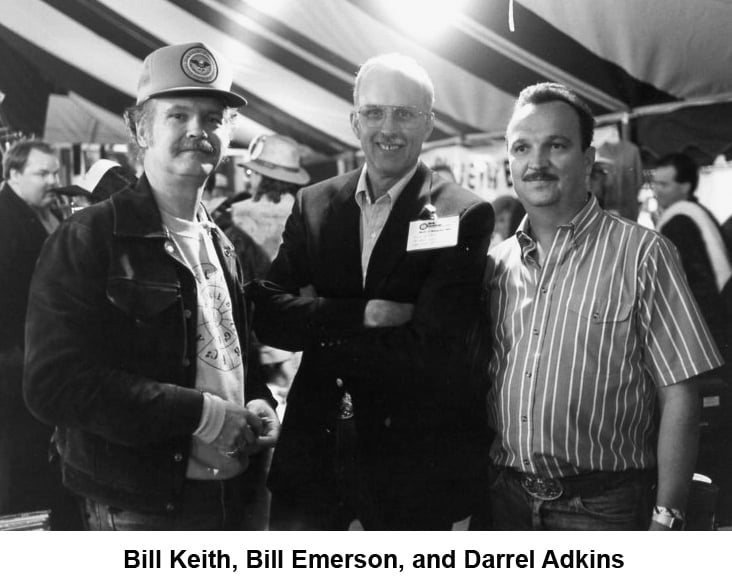
After the Rice Brothers 2 project, which was released in 1994, the next project that Emerson was involved with was with Mark Newton and was released by Pinecastle Records in 1998 under the title Emerson & Newton—A Foot In The Past, A Foot In The Future. The musicians involved in this project included Bill Emerson (banjo), Mark Newton (guitar), Emery Lester (mandolin), Bob Goff (bass), and Rickie Simpkins (fiddle). In John Lawless’ 5-String Quarterly article (Fall 1995), Bill mentioned that he was getting ready to record and tour with a band called The New Group which consisted of Bill Emerson, Mark Newton, Emory Lester, and Bob Goff.
Emory Lester remembers, “The New Group ended up becoming the Emerson & Newton Band after that project was made, but it was the same band. I think it started as The New Group with Bill, Mark, Bobby Goff and Norman Wright back in (I think) 1994. Bill brought me in and I replaced Norman pretty close to the beginning of the thing…they did some local pub and restaurant shows with Norman before I joined it. My time was (again to the best of my knowledge and memory) from 1995 till 1999. We did many shows and, whereas we didn’t really ‘tour,’ we did travel and do a bunch of festivals, like Frontier Ranch in Columbus, Ohio. We did fly to Maine and do the Thomas Point Beach Festival one or two times. We drove all the way to Chicago and back one time. I rode out there with Bill, and that was a very special time because I got to talk for hours with Bill about a number of things during that road trip. We did the Graves Mountain Festival and some shows at that park three or four times each year, due to Mark’s association with that event. Lots of local gigs. We played the Admiral Inn in Manassas, Virginia and Mr. B’s in Fredericksburg on a regular monthly basis for years.”
In May of 1996 the Emerson & Newton Band was scheduled to perform at a post-golf tournament awards show and Bar-B-Que dinner at the Virginia Oaks Golf Course in Gainesville, Virginia. Prior to the show, Bill was standing near the club house and a young employee driving a golf cart (way too fast) whipped around the corner and ran into Emerson. Bill was rushed to the Prince William hospital in Manassas, Virginia. In addition to being badly bruised, he suffered a skull fracture that temporarily affected his hearing.
Regarding the golf cart incident, Emery Lestor recalls, “I arrived at the golf course just after they took him to the hospital. There was a red spot on the pavement and Mark Newton was there to point it out to me and said, ‘Bill hit his head here!’ I didn’t need to know that, but it’s something I’ll always remember. But the show must go on! I definitely remember using Bill’s banjo to play the gig. It was my only chance to really feel like Emerson the banjo player! We went to the hospital after we had played and visited him there.”
More Recordings
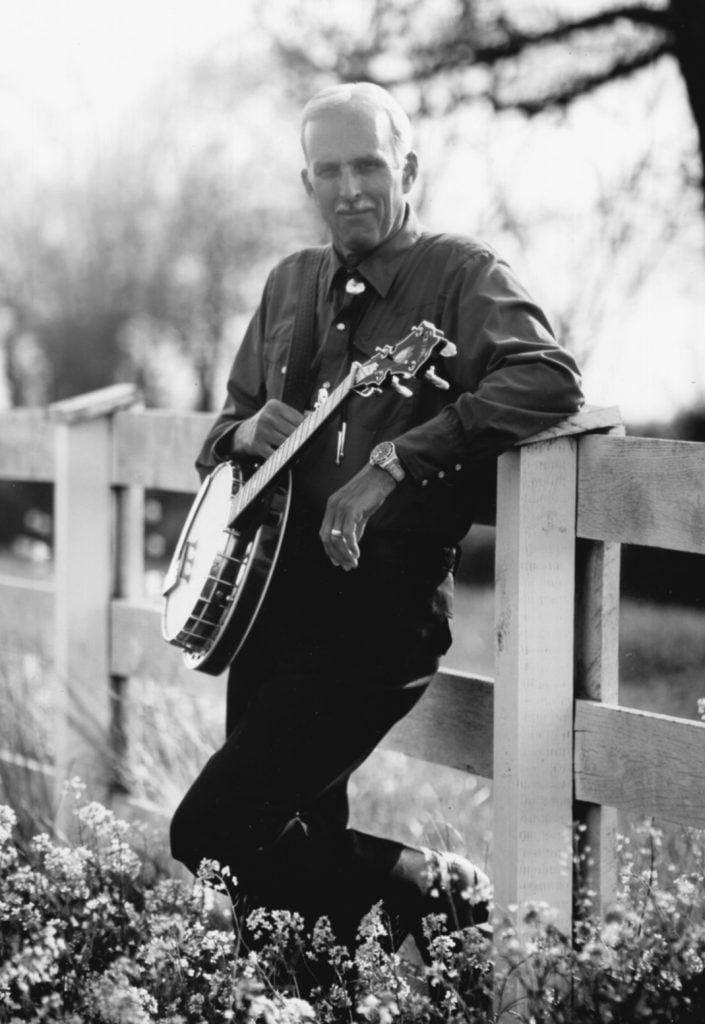
In 1998 Bill played the banjo on Mike Henderson’s Silver Lining album. Henderson was a singer/songwriter who wrote bluegrass songs and hired a group of Virginia-based musicians to record with him—Bill Emerson (banjo), Rickie Simpkins (fiddle), Ronnie Simpkins (bass), Fred Travers (Dobro) and Emory Lester (mandolin). The album was released on Copper Creek Records in 1998. In the liner notes, written by Gary Reid, Henderson is quoted as saying: “I have heard Bill for years, but I doubled my respect for him the day he walked into the studio to work on my project. I was more than a little nervous working in such an atmosphere for the first time. Bill made it easy. His pace fit each song and his quiet confidence gave me the courage to try to sing each song as best I could. He had heard some of my most obscure songs and set the rhythm as it should be played. When a song felt rushed, he would say, ‘Mike, I think you want to sing this slower,’ and he was right. It was a privilege to work with a real live legend.”
In November of 1998 Emerson also worked with his old bandmates Wayne and Bill Yates on their Yates Brothers project It’s Never Really Over. Most of this album was engineered and produced by George Hodgkiss at the Phoenix Productions studio in Browntown, Virginia. Those tracks that were not recorded by Hodgkiss were recorded at the Freeland Recording Company studio in West Virginia. When Bill’s son Mike inquired about this recording in an email to his father, Bill replied, “I wasn’t present when those tracks were initially recorded. I just came in and added my track.” This album was released in 2000. Other musicians who appeared on this recording were Wayne Yates (guitar), Bill Yates (bass), Leon Morris (guitar and harmony vocals), Larry Stephenson and Dave Propst (mandolin), Emory Lester (mandolin and guitar), Pat White (fiddle) and Mike Auldridge (Dobro).
Bill Emerson and Stelling Banjos
In 1990 the Stelling Banjo Company introduced their Red Fox model banjo, which was inspired by Bill Emerson. In a phone conversation conducted in January 2022, Geoff Stelling said that when he attended the International Bluegrass Music Association conference in 1989 in Owensboro, Kentucky the Navy band Country Current was playing there and he noticed that Bill Emerson was playing a Stelling Sunflower model banjo. Stelling approached Emerson and they talked about Stelling building another banjo for Emerson. Since one of Bill’s most popular instrumental tunes was titled “Home of the Red Fox,” Stelling suggested that they inlay an image of a fox on the peghead. Stelling also suggested placing a maple leaf design inlay on the fingerboard. The first banjo was built for Emerson in December of 1989 and the first production model was produced in February of 1990 under the model name the Virginian. The model name was changed to the Red Fox model in 1992.
By 1996, the Stelling Red Fox was the company’s top selling model and it remains one of their best sellers today. In the John Lawless article that was printed in 5 String Quarterly in the fall of 1995, Emerson is quoted as saying, “I am very enthusiastic about Stelling. Geoff’s instruments are very high quality. There are a lot of quality materials and quality workmanship that goes into them, and they are different from all other mainstream banjos.”
In 2005 Stelling put together a recording titled the Stelling Banjo Anthology, that featured Bill Emerson, Alan Munde, Chris Warner, Murphy and Casey Henry, Ned Luberecki, Alvin Breeden, and Keith Arneson. For this project, Bill wrote two new instrumental numbers, “Ticket to Alvarado” and “Little Juniata. ” He also performed “Home of the Red Fox.” The musicians who recorded on these cuts with Bill were Wayne Taylor (guitar), Akira Otsuka (mandolin), Joe Wheatley (bass), and Pat White (fiddle).
Other than recording for the Stelling banjo project, Bill was not very active between 1999 and 2006. His son, Mike, said, “Dad laid the banjo down for a while.” When Bill did decide to get back to recording and performing, he called on Wayne Taylor, Pat White, and Joe Wheatley—all from the Navy band—to help him start recording a new project under the name of the Sweet Dixie band.
The band name was recommended by Bill’s old boss Jimmy Martin. In the Bluegrass Music Hall of Fame and Museum’s Oral Histories Project interview, Bill explained that shortly before Jimmy Martin’s passing (2005), Emerson and Vassar Clements had traveled to Bean Blossom to perform with Martin. It was there that Jimmy Martin said to Emerson, “Big E, you ought to put a band together and call it Sweet Dixie.” In 2006, Emerson did just that.
In the next installment in this series of articles about Bill Emerson, we will present his activities in bluegrass music between 2006 and the time of his passing in 2021.
Share this article
1 Comments
Leave a Comment Cancel Reply
This site uses Akismet to reduce spam. Learn how your comment data is processed.
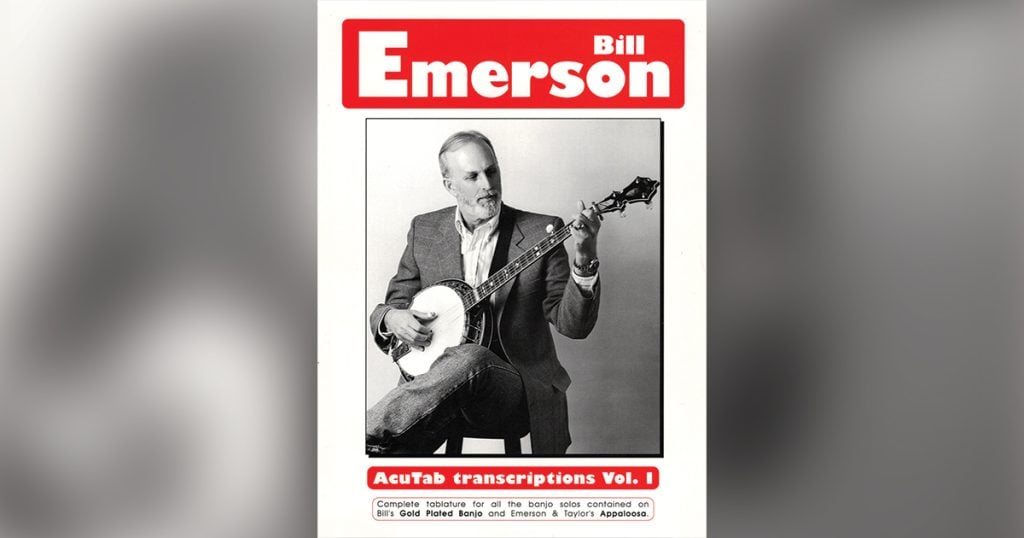
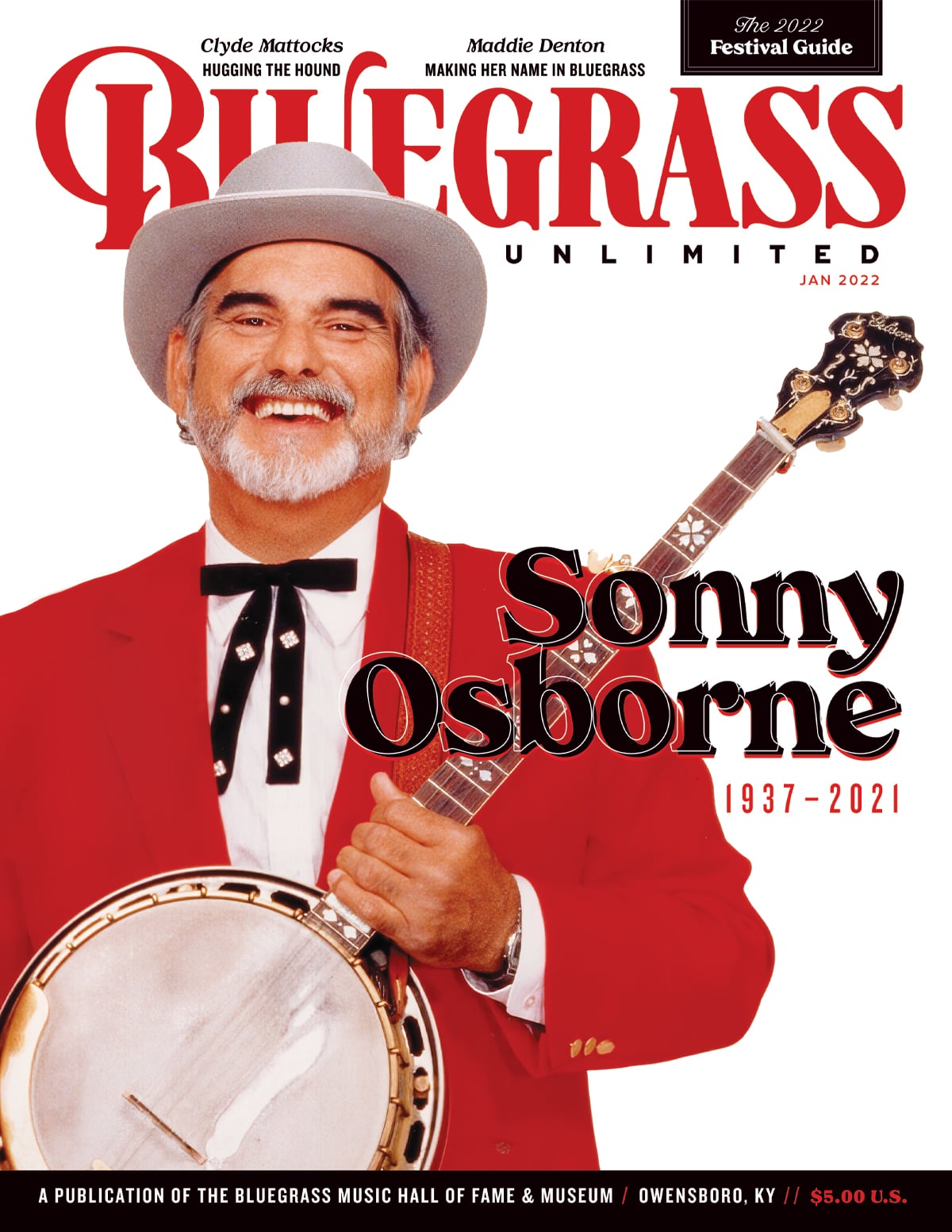
The banjo became an extension of the man! Emerson saw music through a banjo lens. I can’t wait for the final Emerson chapter.